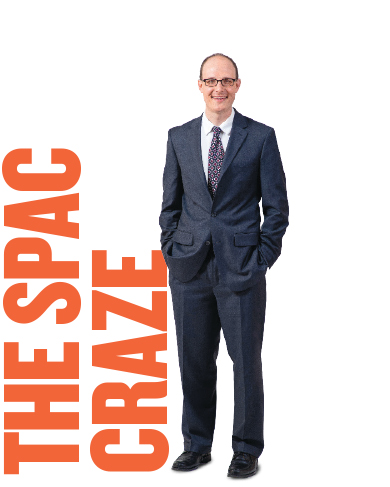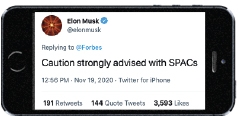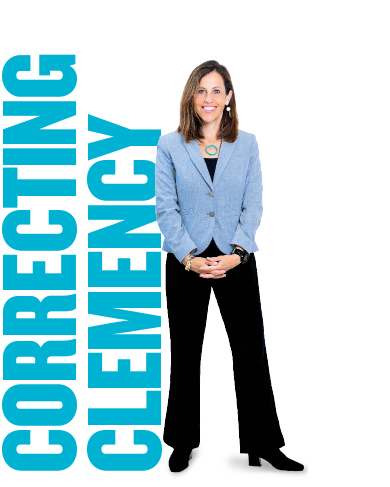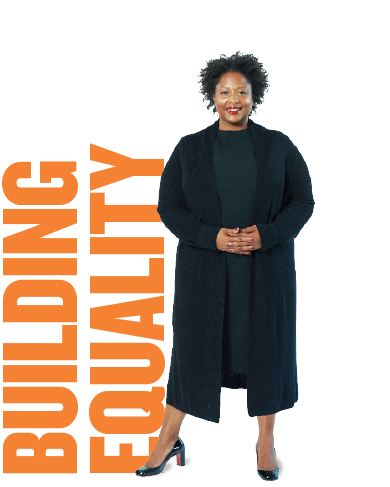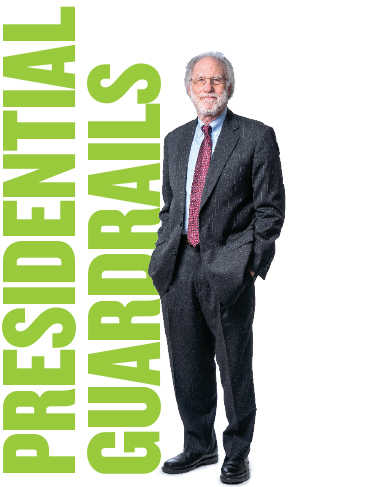Changing the Debate
These examples of recent scholarship from NYU Law are shaping public conversation on subjects such as clemency, infrastructure, presidential power, and the superhot investment vehicles known as SPACs.
BY MICHAEL OREY AND ATTICUS GANNAWAY
ILLUSTRATION BY JOEY GUIDONE
There aren’t many law professors who can claim Elon Musk highlighted their scholarship on Twitter. But that’s what happened last November after a draft of a paper titled “A Sober Look at SPACs,” co-authored by Assistant Professor of Law Michael Ohlrogge, was posted on the internet. And Musk wasn’t the only one to take notice of Ohlrogge’s paper. In late 2020, SPACS—or special purpose acquisition companies, a formerly obscure vehicle for taking businesses public—were a Wall Street phenomenon, attracting billions in investment capital. “A Sober Look,” which dug beneath the hype to uncover hidden costs and overblown benefits, became a viral sensation.
Scores of press accounts and social media postings cited the paper. Podcasts promoted it. Speaking invitations flooded in. By April 2021, when Ohlrogge presented the paper at an NYU Law faculty workshop, it had been downloaded from SSRN, a website devoted to dissemination of scholarly research, 22,000 times. All this, far in advance of the paper’s formal publication, slated for January 2022 in the Yale Journal on Regulation.
“I wanted to congratulate you,” Sudler Family Professor of Constitutional Law Richard Pildes said at the workshop, prefacing a question about the paper. “It’s just so rare to have a major market innovation or policy innovation that someone writes a piece about and so quickly has such a major effect on the debate.”
The term “scholarship” may connote work that is rarefied, abstruse, and intended largely for other academics. But legal scholarship is almost always grounded in real-world issues. In remarks delivered at NYU Law in 2011, Cass Sunstein, now a faculty member at Harvard Law School, emphasized the value of studying and advancing ideas about the law. “What you do … really matters,” he told the audience of primarily faculty and students. “People will pick it up, people will listen to it, and it will feed into a kind of river that is an intellectual tradition that matters and affects lives.”
How scholarship finds its way into that river, and the nature of its impact, varies greatly. These four case studies show how work by NYU Law faculty members has filtered into the public conversation around an issue, and in some instances has shaped legal rulings or public policy.
The SPAC Craze
SPACs are publicly listed shell corporations, formed to find a private company to merge with and thus take public. They have been touted as an easier and cheaper way for companies to go public, compared to an initial public offering (IPO), and are often called “poor man’s private equity,” because they allow individual investors to make bets on businesses before they go public. The potential for SPAC sponsors (who form the shell companies) to reap big windfalls has even drawn celebrities into the game, including Serena Williams, Jay-Z, and Paul Ryan, former speaker of the US House of Representatives. Beginning in mid-2020, the number of SPAC offerings exploded, and they quickly became the hottest thing on Wall Street, accounting for about 50 percent of all money raised through IPOs in 2020 and an even higher percentage in early 2021.
But Michael Ohlrogge and his co-authors—Stanford Law Professor Michael Klausner and Emily Ruan, Klausner’s research assistant, now at Boston Consulting Group—threw cold water on the craze. “We find that costs built into the SPAC structure are subtle, opaque, and far higher than has been previously recognized,” they wrote, after conducting an in-depth study of 47 SPACs. Noting that the large majority saw their post-merger prices fall, and that the investing public bore the burden of their highly dilutive cost structure, they recommended regulatory measures to address their concerns.
In September 2020, Ohlrogge and Klausner presented a near-final version of their paper at the Law, Accounting, and Business Workshop at the University of California, Berkeley, School of Law. They then had some email exchanges with Scott Kupor, managing partner of venture capital firm Andreessen Horowitz, after being introduced by Berkeley Law Professor Robert Bartlett. On October 30, the day they posted the paper to SSRN, Kupor tweeted it to his 40,000 Twitter followers, calling it “fascinating research.” As others retweeted Kupor, Reddit users began discussing the paper on a forum devoted to SPACs.
Discovering the paper through a link on Reddit, Wall Street Journal reporter Alexander Osipovich realized “it was one of the best things I’d ever read on SPACs,” he said in an email. On November 13, the Journal published “Investors Flock to SPACs, Where Risks Lurk and Track Records Are Poor,” giving “A Sober Look” its first mainstream media attention.
Forbes reporter Antoine Gara, who learned about the paper from Kupor’s tweet, was similarly impressed, noting via email that Ohlrogge and his co-authors “aggregated and analyzed exactly what everyone watching the market was looking for.” Forbes’s story, “How SPACs Became Wall Street’s Money Tree,” ran on November 19. “Caution strongly advised with SPACs,” Elon Musk wrote, tweeting the Forbes piece to his 50 million followers.
Subsequent months saw a torrent of additional media coverage in outlets including the New York Times, the Financial Times, Bloomberg, the New Yorker, Axios, Vox, Reuters, public radio’s Marketplace, and elsewhere. Klausner and Ohlrogge have fielded emails and phone calls from journalists in Brazil, China, Japan, Germany, the United Kingdom, and Singapore, and their paper is being translated for publication in a Chinese law journal. Editorials in the Financial Times and Bloomberg cited “A Sober Look” as they urged caution on SPACs. Several podcasts featured the piece, including programs produced by Goldman Sachs and Freshfields Bruckhaus Deringer.
As the rosy glow around SPACs began to fade, the number of lawsuits against SPACs and their directors mounted, with allegations of inadequate disclosure and breach of fiduciary duty. One complaint filed in federal district court in Manhattan even cited “A Sober Look.” Klausner says he advised several plaintiffs’ firms, and he and Ohlrogge gave presentations at two major law firms in New York. One, at Cravath, Swaine & Moore, drew nearly 150 of the firm’s lawyers.
“We’re always on the lookout for new perspectives for our lawyers to consider, and this paper provided unique insights,” says Cravath partner Jenny Hochenberg, who organized the program. It was, she says, one of the firm’s best attended topical discussions, and “it generated very lively dialogue with our partners and associates.”
“A Sober Look” also appears to have played a key role in educating policymakers. Ohlrogge presented the findings to the US Securities and Exchange Commission’s Investor Advisory Committee in March. “I thought your paper was great,” committee member Sandra Peters, a financial analyst and senior head of global financial reporting policy for the CFA Institute, told Ohlrogge. She added: “I think your work…is really what the market needs to understand to make informed decisions about the [investment] return.”
Addressing a US House of Representatives subcommittee on May 26, SEC Chairman Gary Gensler cited the paper, noting that SPACs may be costlier than traditional IPOs, with retail investors bearing the burden. Gensler said he had asked SEC staff for recommendations on possible rules or guidance for the commission to issue in this area. Additionally, US Senator John Kennedy introduced legislation that would require enhanced disclosure for SPACs. “A Sober Look” was “very, very helpful to me while I was researching the topic,” Natalia Díez Riggin, senior legislative assistant to Kennedy and staff director of the Economic Policy Subcommittee, said in an email.
Amid the flurry of speaking invitations and press attention for their paper in early 2021, Ohlrogge recalls, he spoke to Klausner by phone and said, “Someday, we’ll go back to being irrelevant, and we’ll look back on this with nostalgia. But for now, it’s rather overwhelming.”
However, three months after Ohlrogge’s April presentation at the NYU Law faculty workshop, the attention showed little sign of letting up. As of late July, SSRN downloads of “A Sober Look” totaled more than 27,000, making it the fourth most downloaded paper from the site over the previous 12 months. Many press accounts, meantime, began to discuss the possibility that the SPAC bubble had burst.
Finding an Audience
In summer 2020, Michael Klausner, Michael Ohlrogge, and Emily Ruan begin an analysis of 47 recent special purpose acquisition companies (SPACs). “It turned out that almost everything people were saying about SPACs was partially or totally wrong,” Ohlrogge says.
October 30, 2020
Their paper, “A Sober Look at SPACs,” is posted to SSRN.
November 13, 2020
A Wall Street Journal article cites the paper under the headline “Investors Flock to SPACs, Where Risks Lurk and Track Records Are Poor.”
November 19, 2020
Elon Musk weighs in.
February 2, 2021
Klausner appears on a Goldman Sachs podcast, “The IPO-SPAC-Tacle.”
February 24, 2021
In an editorial—“Why London should resist the Spac craze”—the Financial Times notes, “A recent academic paper laid bare the embedded costs.”
March 11, 2021
Ohlrogge presents to the Securities and Exchange Commission (SEC) Investor Advisory Committee. “We’re seeing more evidence on the risk side of the SPACs equation as we see studies showing that their performance for most investors doesn’t match the hype,” then-acting SEC chair Allison Herren Lee tells Yahoo Finance.
April 8, 2021
John Coates ’89, acting director of the SEC’s division of corporation finance, cites “A Sober Look” in a statement noting growing alarms about SPAC risks.
May 19, 2021
Ohlrogge presents at an internal SPAC discussion for the International Finance Corporation, the private-sector arm of the World Bank Group.
May 24, 2021
All four presenters at a US House of Representatives hearing on SPAC regulation reference “A Sober Look.”
Correcting Clemency
In an April 2019 opinion piece published on CNN.com, Senator and then-presidential candidate Amy Klobuchar called for establishment of a federal clemency advisory board, moving the clemency process out of the US Department of Justice (DOJ). Klobuchar cited work by Rachel Barkow, Charles Seligson Professor of Law, and her frequent co-author, Mark Osler, a professor at the University of St. Thomas Law School in Minneapolis. Over the course of 2019, a half dozen other Democratic presidential candidates endorsed the idea.
The US Constitution vests the president with power to grant clemency—which includes pardons and sentence commutations—to people convicted of federal crimes. Barkow, who is faculty director of the Law School’s Peter L. Zimroth Center on the Administration of Criminal Law, says she began to urge the use of that power to address the excessive number of people in federal prisons in 2008, while serving on the Criminal Justice Policy Team for Barack Obama’s presidential campaign. In 2009, she published “The Politics of Forgiveness: Reconceptualizing Clemency,” focused primarily on states, where governors also have clemency power. The article advocated for the creation of clemency boards, in part to insulate governors from the often emotionally charged politics around clemency grants.
In three subsequent law review articles, Barkow made the case for reinvigorating presidential clemency as a tool of criminal justice reform, and for removing it from DOJ. “The current environment of expansive federal criminal laws and aggressive charging by federal prosecutors has produced a criminal justice system of unprecedented size and scope,” she wrote in the New York University Law Review in 2015. Clemency, she said, “is a key tool for addressing poor enforcement decisions and injustices in this system.” But DOJ, in her view, is inherently conflicted. “Putting clemency within the same portfolio as the person who’s in charge of all criminal prosecutions doesn’t create an ideal climate for having that person be very pro-clemency,” Barkow said on the Justice in America podcast.
New York Times editorials in 2014 and 2019—both pointing to Barkow’s and Osler’s work—called for creation of a clemency commission independent of DOJ. In March 2020, Barkow told a House subcommittee that asking an agency whose main mission is law enforcement “to flip perspectives and think of sentence correction and redemption is no small request.” And, following the 2020 election, there seemed to be a real possibility the incoming Biden administration would remove clemency from DOJ’s purview. One of the candidates expressly supporting the step was Kamala Harris, the new vice president; it was also part of the 2020 Democratic Party platform.
As much as it has shaped public debate, Barkow’s suggested reform has not yet been translated into policy. In May, the New York Times reported that the Biden administration was likely to leave the clemency process inside DOJ.
Barkow quickly took to Twitter. “I want to highlight some of the things in this article that are worrisome to me because I fear this is a bad sign of where the administration is headed on clemency and criminal justice more generally,” she wrote, critiquing the Biden team’s approach in a 27-tweet thread for her 21,000 followers. Josh Gerstein, a senior legal affairs contributor for Politico, then highlighted Barkow’s commentary for his 80,000 Twitter followers, noting, “If the NYT story was supposed to assure advocates that Biden and his aides ‘get it’ on pardons, it seems to have failed.”
And Barkow is not giving up the fight. A former commissioner on the US Sentencing Commission, she testified in June before a House subcommittee on sentencing reform and slipped in a comment about clemency. In a July New York Times op-ed, she and Osler exhorted the Biden administration not to backtrack on meaningful reform.
“Mark and I have more people in our corner now arguing that taking DOJ out of its gatekeeping role on federal clemency is the right thing to do, and I remain hopeful that eventually this will be fixed,” Barkow said in an email. “There are just too many people incarcerated right now serving excessive sentences, and I won’t give up trying to get them justice.”
Building Equality
In 2018, Professor of Clinical Law Deborah Archer and her Civil Rights Clinic students started to engage with residents, academics, community groups, and government agencies considering what to do with an aging interstate highway overpass in Syracuse, New York. Built in the 1960s, it had cut through and destroyed a once-vibrant Black neighborhood. The clinic’s work inspired Archer to publish an article on racial equity and highway construction; her ideas from that piece would reverberate through the highest levels of the incoming Biden administration as infrastructure became a top federal priority.
“White Men’s Roads Through Black Men’s Homes’: Advancing Racial Equity Through Highway Reconstruction,” published last fall in the Vanderbilt Law Review, is the first piece of legal scholarship to offer an in-depth look at racial equity in modern highway redevelopment. The article explores how the massive infrastructure boom prompted by the Federal-Aid Highway Act of 1956 disproportionately displaced Black communities. Predominantly Black areas were often leveled in the name of “slum clearance,” or new highways served as physical barriers between Black and white neighborhoods.
Archer’s article discusses the inadequacy of current civil rights laws and analytic frameworks in addressing racial inequity in development projects. She urges states and localities to utilize racial equity impact studies (REISs)—already used in contexts such as criminal legal reform and public transportation—before commencing highway redevelopment projects. Stressing monitoring and accountability, Archer advocates for a “deeply collaborative” REIS process in which local stakeholders help assess the full impact of a project on the community.
The article has gained traction far beyond what Archer anticipated. “I actually thought it wasn’t going to go anywhere,” she admits, given the stalling of infrastructure initiatives during the Trump administration and the impact of the COVID-19 pandemic.
But then Joe Biden, whose campaign promises had included massive infrastructure investment, won the 2020 election. In December 2020, after Pete Buttigieg announced his nomination as secretary of transportation on Twitter, people tweeted back at Buttigieg that he should read Archer’s article. A former Archer colleague from the NAACP Legal Defense and Educational Fund who had also worked in the Department of Transportation asked Archer for copies to share inside the department. In a meeting, Buttigieg raised points from Archer’s article with her former co-worker and indicated that he and his staff would engage on those issues, Archer says. She notes that she saw Buttigieg’s public language start to shift to reflect increased awareness of racial equity matters.
Archer reports that her research also prompted Secretary of Energy Jennifer Granholm’s chief of staff, Tarak Shah, to take a fresh look at how the Department of Energy was thinking about REISs related to energy infrastructure. In April, a US district court judge in the Central District of California, ordering the city and county of Los Angeles to take numerous actions to address homelessness, quoted Archer on transportation infrastructure and race twice in his opinion. Among the news outlets to cover Archer’s ideas are the New York Times, the Washington Post, NPR’s Morning Edition, and the PBS NewsHour.
Archer remains equal parts optimistic and realistic about US infrastructure policy. The Biden administration’s infrastructure plan “potentially represents a historic investment in these communities that have been traditionally ignored and underfunded,” she says.
“But I think the challenge is that this conversation and a statement of intention for it to result in racial equity is really not enough,” Archer says. “We have to pay close attention to how and where the funding is going to be used—whether any of it is going to be used to first create parity and equity, before we move all of us forward.”
Presidential Guardrails
Whatever one’s political persuasion, most Americans can agree that Donald Trump cast aside many long-accepted norms of the US presidency. That’s why, when Bob Bauer, former White House counsel in the Barack Obama administration, and Jack Goldsmith, who headed the Office of Legal Counsel in the George W. Bush administration, began discussing a potential book in spring 2019 on the history of the White House counsel’s office, the project soon evolved into something different entirely.
In After Trump: Reconstructing the Presidency, Bauer, professor of practice and distinguished scholar in residence at NYU Law, and Goldsmith, a professor at Harvard Law School, argue for broad reform and suggest more than 50 specific changes to the laws, regulations, and norms that govern the presidency. The need for such reforms did not originate with the Trump administration, Bauer says. Prior administrations, both Democratic and Republican, advanced expansive claims of executive authority, Bauer notes. The Watergate era prompted a decades-long debate about the reach of the “imperial presidency.”
The book’s proposals focus on foreign state influence, financial conflicts of interest, the disclosure of tax returns, presidential pardons, the independence of the Justice Department, special counsel investigations, the structure of the Office of White House Counsel, war powers and nuclear weapons, and vacancies in the executive branch, among other issues. An appendix contains draft text for some proposed reforms. The co-authors write that “a comprehensive examination of the many fissures in the structure of the presidency” is a tall order, but they are nevertheless intent on framing the debate.
Bauer, who served as a senior advisor for the 2020 Biden campaign and co-led the campaign’s legal operation, certainly has the new administration’s ear. He and Goldsmith also command considerable respect on both sides of the aisle. When After Trump—the inaugural book publication of the influential Lawfare blog—was released in September 2020, members of Congress immediately reached out. Bauer and Goldsmith discussed their proposals with both Republicans and Democrats, and some of their reforms related to the pardon power appear in at least one bill reported out of the House Judiciary Committee. The two testified in March before the House Foreign Affairs Committee about proposed amendments to the War Powers Resolution to allow the reclaiming of congressional war powers. They argued in particular for revisions to the Authorization for Use of Military Force (AUMF) of 2001 passed in the wake of 9/11, and for the repeal of the 2002 AUMF that authorized the invasion of Iraq.
After Trump’s ideas have been covered by the New York Times, the Atlantic, NPR’s Fresh Air, the Guardian, the Los Angeles Review of Books, Vox, and Slate’s podcast Amicus with Dahlia Lithwick. Bauer and Goldsmith have also published op-eds in the New York Times and the Washington Post.
Bauer says that, the book’s title notwithstanding, it is intended to be “a forward-looking agenda for reform, and not only a critical examination of the abuses of the Trump years…. There is Republican support for chunks of what we’re talking about here. It always helps the discussions when Republicans are persuaded that the purpose is not only to fight again about Trump. They recognize Trump as having, in his presidency…exposed real weaknesses in the constraints on the presidency, but if it’s an institutional line of analysis, then that tends to bring more Republicans into the conversation. So far we’ve been very happy to see that, and we think that’s the basis for something useful to be done here.”
Michael Orey is public affairs director and Atticus Gannaway is senior writer at NYU Law.
Posted September 9, 2021.


